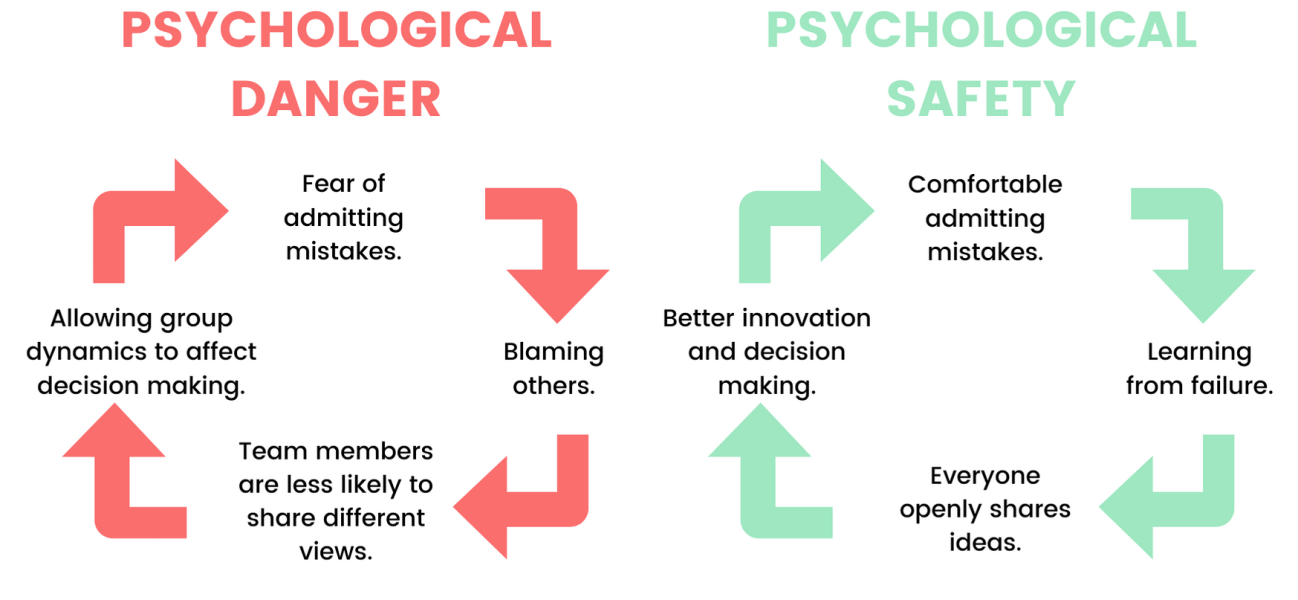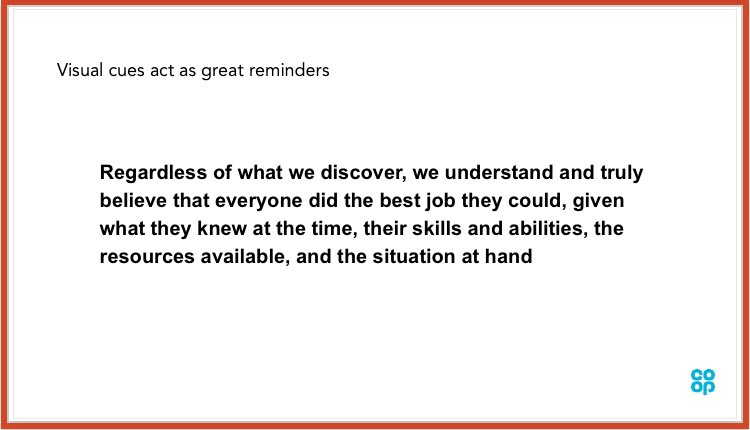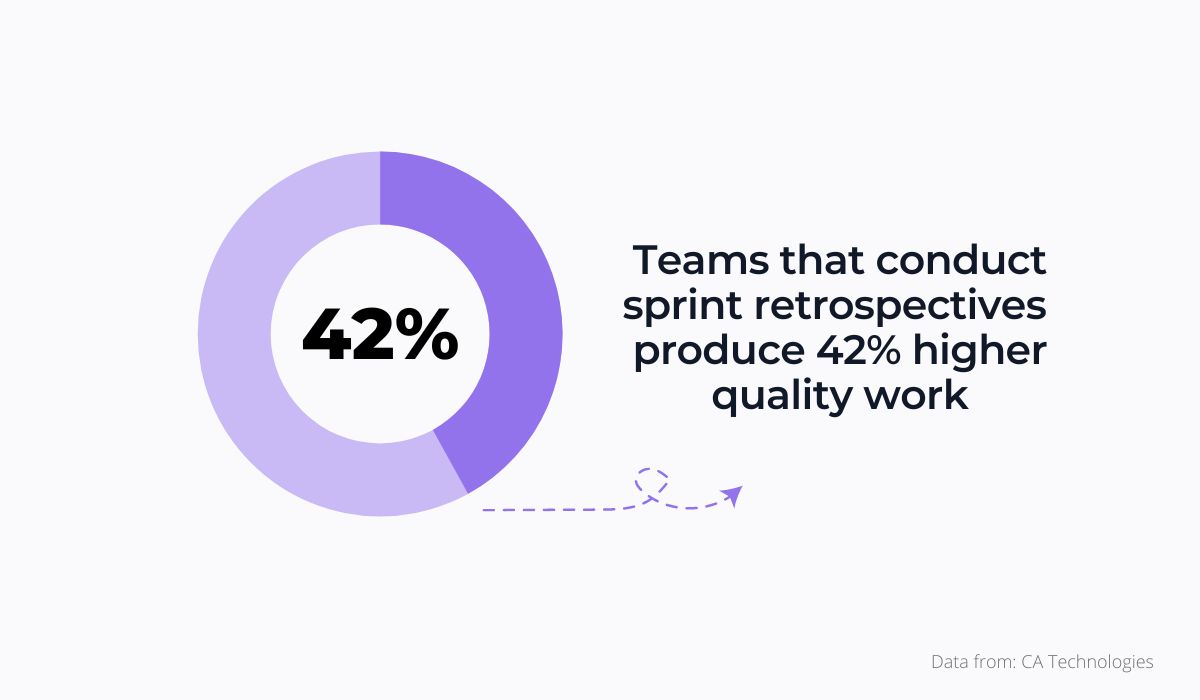
In this article, we’ll discuss why it is important to have these meetings, what are their biggest benefits and how to run them more effectively.
Stay tuned!
Table of Contents
Facilitating transparency
Undoubtedly, one of the biggest benefits of sprint retrospectives is that they promote transparency within a software development team.
But what really is transparency, and why is it so essential for the software development industry?

Get unreal data to fix real issues in your app & web.
According to Glassdoor, workplace transparency refers to a philosophy in which information flows unhindered within a company.

The idea behind this is that when everyone has access to the same information, it makes it easier for them to make decisions and collaborate effectively.
However, this isn’t always the case, as we can see from the Slack Future of Work Study, where an impressive 87% of employees said they hoped that their future company would be transparent.

Retrospectives are an excellent way to turn those numbers around by encouraging sharing of information and giving everyone a chance to voice their thoughts, suggestions, and ideas.
However, in order for retrospectives to be truly transparent, one prerequisite must be met: psychological safety.
Psychological safety is a term coined by Amy Edmondson, a professor at Harvard Business School, and it refers to a feeling of security, trust, and confidence in the work environment.

In fact, as the image above demonstrates, it’s precisely because of psychological safety that employees feel free to express their opinions without fear of repercussions or judgment.
Without a safe space for dialogue, they may feel hesitant to share information and their honest thoughts during a retrospective.
And transparency it’s not merely about sharing information—it’s about sharing information with everyone.
Or, as Aurimas Adomavicius, Head of Product at Cognizant, puts it:
“There’s no in-between with transparency. You’re either all in, or you’re restricting information and trust.”
How can you then create a work environment in which your developers feel safe enough to be transparent about what they’re working on and how it’s going?
Implementing techniques, such as a Mad-sad-glad, can make the atmosphere during retrospectives become more welcoming and open.

During the Mad-sad-glad exercise, you can have the team go around and share which parts of the sprint made them feel one of the titular emotions, as depicted in the image above.
Sharing details like this promotes a culture of openness and helps team members feel connected to one another, which can in turn generate feelings of psychological safety among them.
That way, trust will be created, and a culture of transparency will be established.
Creating a collaborative environment
Sprint retrospectives are an extremely efficient way to collaborate among team members.
As developers sit down together and discuss what happened during the sprint, this process inevitably sparks an exchange of ideas.
When we consider that 39% of employees feel that there isn’t enough collaboration within their company, it becomes clear just how essential sprint retrospectives can be in creating a more cooperative workplace.

Agile coach Michael de la Maza is also of the opinion that retrospectives are a crucial part of creating a collaborative work environment.
After each sprint, he explains, there’s a retrospective during which team members turn to each other for feedback and advice, and with regular repetition, effective collaboration becomes a habit.

Knowing that collaboration is critical for the success of the sprints, many team leaders implement various strategies in their retrospectives to further encourage developers to work together.
One of these strategies is, for instance, a retrospective activity known as the Starfish. In a nutshell, this activity helps participants consider various levels of collaboration.

By dividing the board into five different sections (Start doing, More of, Less of, Keep doing, and Stop doing), the activity enables developers to realize how their individual actions affect others.
If some developers feel like a team is doing, for example, too much testing, they can make a note of it in the Stop doing section.
By taking this approach, they encourage other team members to work together and come up with creative solutions that will replace over-testing.

The activity is simple, but it is effective at helping teams become aware of their interdependence.
And the tweet and pictures above speak volumes about how, in the end, it can impact the team’s ability to cooperate.
To sum up, sprint retrospectives can be a powerful tool for improving team culture.
By encouraging open communication and listening to one another, teams can strengthen their relationships and grow together as a unit.
Identifying issues early
Sprint retrospectives allow software developers to identify issues early in the development cycle and fix them before they become insurmountable.
And the most efficient way to do that is by conducting regular blameless post-mortems.
What is a blameless post-mortem, you may wonder?
In a nutshell, it’s a retrospective session where no one is blamed for anything that went wrong.
In other words, when an issue is identified in a sprint retrospective, instead of pointing fingers and assigning blame, team members attempt to find solutions together.

The picture above shows the eight steps teams can go over to quickly get a grasp on what caused the problem.
Then, they figure out how to fix it—and all this without looking for someone to blame.
This is extremely important because if developers know that they won’t be punished for making mistakes, they’ll feel more comfortable reporting problems.
That’s why Steven Allcock, an enterprise services manager at Esure Group, likes to start his retrospectives with the following statement:

This sets a tone for the retrospective, encouraging everyone to step forward and report issues.
Let’s see how this works in practice by looking at the example from Hootsuite.
One of their engineers accidentally deleted the entire Hootsuite app from the LinkedIn Developer Portal, making it impossible for their users to post on LinkedIn or open new accounts.

After that, they conducted a post-mortem to understand what happened and how they could mitigate the impact on their users.
By doing this, they were able to identify the root cause of the problem and prevent other major roadblocks from happening in the future.
This is why it’s important to have post-mortem retrospectives in place: they allow you to catch problems immediately and avoid bigger, costlier issues down the line.
Discussing process improvements
Sprint retrospectives are valuable not solely for the chance to detect issues early on but also to improve the team’s processes.
During a retrospective, team members can assess what went well during the sprint as well as where improvements are needed for future sprints.
The team can then apply these insights to identify opportunities for improvement and make their processes more efficient.
CA Technologies’ report supports this claim: it states that teams who engage in retrospectives produce higher-quality work.

In their book Agile Retrospectives–Making Good Teams Great, Esther Derby and Diana Larsen explain this perfectly:
“Retrospectives help teams—even great ones—keep improving.”
However, in order for retrospectives to actually result in improved processes, they need to be conducted according to a few principles and an established structure.
For instance, a typical sprint retrospective usually covers four crucial areas:
- What went well during the last sprint?
- What can we improve?
- How can we improve it?
- What will we do differently next time?
The picture below demonstrates this process:

As you can see in the picture, your team first answers three of the key questions from the list.
After that, they do a self-analysis, then do a deep dive into the problem itself and create a presentation with steps for improvement.
It’s important that the end result is a list of concrete steps that the team can take.
The main takeaway here is that by conducting structured retrospectives that result in action, you can ensure that your team’s processes are improving over time.
This is particularly important in software development, where the pace of innovation is rapid, and you need to be able to adjust your processes to keep up.
Improving team morale
When conducted right and with the appropriate intention in mind, retrospectives can improve team morale just as much as they do processes.
They can create a welcoming environment, increase feelings of solidarity among team members, and give a sense of purpose to their work, resulting in a better work culture overall.
The Wrike Happiness Index found that most employees would be willing to take a pay cut in exchange for more satisfaction at work.

That just proves that employees want to feel like they’re doing something meaningful and worthwhile. Regular retrospectives can help provide that feeling.
Jean Hsu and Edmond Lau, co-founders of Co Leadership, also can’t stress enough the importance of retrospectives when it comes to enhancing the team’s morale.
They state:

However, they argue that teams often only use retrospectives to analyze what went wrong, completely ignoring what is going well.
They focus on mistakes and believe that the best use of a retrospective is to spend time discussing actions or processes that could be improved rather than celebrating successes.
But, they continue, conducting retrospectives that make developers feel excited and like they’re making a difference can have a huge impact on their morale.
That’s why, after a few months of initial tuning, they decided to break down their retrospective process into the following five steps:
- happiest moments
- big wins
- assessments of progress
- lessons learned
- gratitudes
As you can see, instead of focusing on what went wrong, they created a space where they could share what went right and celebrate their team’s accomplishments.
And as shown in the tweet below, Edmond Lau states that after their retrospectives, he always feels energized and motivated.

Of course, you don’t have to suddenly change your sprint retrospective to fit this model: a few well-chosen words of acknowledgment or encouragement can be just as effective.
The bottom line here is that you use retrospectives to give your developers a sense of accomplishment and recognition and a feeling their work matters.
As you can imagine, that can do wonders when it comes to boosting their motivation and overall satisfaction.
Aiding skill development
In software development teams, retrospective meetings are one of the main settings in which learning happens.
This is because they are a place where the team collects information about what happened during the sprint and identifies challenges.
That way, they learn new ways of working and come up with better methods that eliminate their reliance on default thinking patterns.
And that means that they are developing new skills and improving old ones.
Considering that upskilling and reskilling opportunities in the workplace make tech employees more motivated at work, it makes sense to use retrospective meetings as a platform for learning.

However, although retrospectives provide a great upskilling opportunity, many teams fail to live up to that potential.
Let’s look at what Luis Gonçalves, author and management consultant, has to say about this:
“The way that I see most people running their Agile Retrospectives does not really allow the team to learn. For most people, Agile Retrospectives are just a simple mechanical process used to generate some ideas regarding how the team can improve.”
Instead, he thinks that retrospectives should focus more on the learning than on the outcome, as it’s the learning that will provide value and improve your teams.
That’s why many teams today implement different techniques into their retrospective model, as it allows them to get more out of their retrospectives.
For example, the WRAP method of conducting a retrospective (Wishes, Risks, Appreciations, Puzzles) can help a team think about different possibilities and get out of its usual way of thinking.

The process is pretty straightforward: during the brainstorming, developers jot down their own original ideas when trying to answer these questions:
- What would you like to happen?
- What are some of the dangers that could threaten the project?
- What did we like during the previous sprints?
- What issues or puzzles currently confront the team and remain unresolved?
In the picture below, you can see how a board of WRAP retrospectives might look in practice.

WARP encourages team members to think big and push the envelope when it comes to generating ideas.
In addition to the usual knowledge transfer and learning that occurs during retrospectives, this practice enables them to further develop their creative thinking and problem-solving abilities.
Conclusion
To sum up, sprint retrospective meetings can play a key role in delivering successful projects.
An open discussion with your team, in which you all work together to improve your agile process, is a great way to keep everyone motivated and on track.
On the other hand, retrospectives can do their magic when it comes to improving the team’s morale and skills too.
We hope that after reading this article, you now have a better understanding of why sprint retrospective meetings are important, how to run them well, and how they can help your team deliver projects more effectively.




